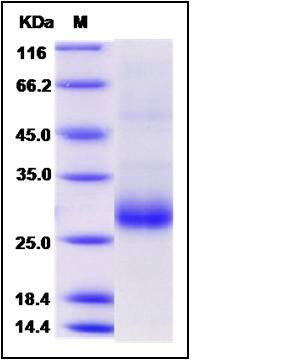Human RANKL / OPGL / TNFSF11 / CD254 Protein
CD254,hRANKL2,ODF,OPGL,OPTB2,RANKL,sOdf,TRANCE
- 100ug (NPP4328) Please inquiry
| Catalog Number | P11682-HNCH |
|---|---|
| Organism Species | Human |
| Host | Human Cells |
| Synonyms | CD254,hRANKL2,ODF,OPGL,OPTB2,RANKL,sOdf,TRANCE |
| Molecular Weight | The recombinant human TNFSF11 consists of 182 amino acids and has a calculated molecular mass of 20.5 kDa. In SDS-PAGE under reducing conditions, the apparent molecular mass of the protein is approximately 27 kDa due to the glycosylation. |
| predicted N | Gly 63 |
| SDS-PAGE |  |
| Purity | > 95 % as determined by SDS-PAGE |
| Protein Construction | A DNA sequence encoding the human TNFSF11 (O14788-2) (Gly 63-Asp 244) was expressed. |
| Bio-activity | 1. Immobilized human TNFSF11 at 10 μg/ml (100 μl/well) can bind biotinylated human TNFRSF11B-His (P10271-H08H), The EC50 of biotinylated human TNFRSF11B-His (P10271-H08H) is 5.7-13.4 ng/ml. 2. The bioactivity of hRANKL was determined by measuring the ability of hRANKL to induce TRAP activity in Raw 264.7 cells. The ED50 for this effect is typically 1.5-7.5 ng/mL. |
| Research Area | Immunology |Signal Transduction |Growth Factor & Receptor |Tumor Necrosis Factor (TNF) & Receptor |Tumor Necrosis Factor (TNF) |
| Formulation | Lyophilized from sterile PBS, pH 7.4 1. Normally 5 % - 8 % trehalose, mannitol and 0.01% Tween80 are added as protectants before lyophilization. Specific concentrations are included in the hardcopy of COA. |
| Background | Tumor necrosis factor ligand superfamily member 11, also known as Receptor activator of nuclear factor kappa-B ligand, Osteoprotegerin ligand, TNFSF11, RANKL, TRANCE, OPGL and CD254, is a single-pass type II membrane protein which belongs to the tumor necrosis factor family. The receptor activator of nuclear factor-kappaB ligand (RANKL), its cognate receptor RANK, and its natural decoy receptor osteoprotegerin have been identified as the final effector molecules of osteoclastic bone resorption. RANK and RANKL are key regulators of bone remodeling and regulate T cell/dendritic cell communications, and lymph node formation. Moreover, RANKL and RANK are expressed in mammary gland epithelial cells and control the development of a lactating mammary gland during pregnancy. Genetically, RANKL and RANK are essential for the development and activation of osteoclasts and bone loss in response to virtually all triggers tested. Inhibition of RANKL function via the natural decoy receptor osteoprotegerin (OPG, TNFRSF11B) prevents bone loss in postmenopausal osteoporosis and cancer metastases. Importantly, RANKL appears to be the pathogenetic principle that causes bone and cartilage destruction in arthritis. RANK-RANKL signaling not only activates a variety of downstream signaling pathways required for osteoclast development, but crosstalk with other signaling pathways also fine-tunes bone homeostasis both in normal physiology and disease. In addition, RANKL and RANK have essential roles in lymph node formation, establishment of the thymic microenvironment, and development of a lactating mammary gland during pregnancy. |
| Reference |
